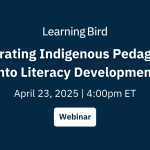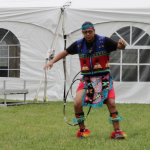Your Role in the International Decade of Indigenous Languages
Following the success of the International Year of Indigenous Languages in 2019, the United Nations, and the over 50 member countries, believed they needed to do more for Indigenous languages and Indigenous human rights. The result was the Los Pinos Declaration in 2020, which announced 2022-2032 as the International Decade of Indigenous Languages. What does that mean for Indigenous and non-Indigenous people in Canada, and how can you get involved? Keep reading to find out!
What are the goals of the International Decade of Indigenous Languages?
In an interview with CBC, Chief Leroy Denny of Eskasoni First Nation, the largest Mi’kmaw-speaking community in the world, said, “If an elder passes away, it’s like a library burns down, I was told.” Language is closely linked to identity, traditional knowledge, worldview, and ways of being. Each language is like a distinct universe. Unfortunately, many Indigenous languages are at risk of extinction. The loss of these languages results in a significant loss of human rights. Language loss restricts freedom of expression, access to services, and participation in cultural life, among many other rights.
Protecting Indigenous languages is paramount to upholding Indigenous human rights. It also guarantees the success of all people in the future. The Global Action Plan for the International Decade of Indigenous Languages aims to ensure “Indigenous languages are preserved, revitalized, promoted and used across all socio-cultural, economic, environmental, and political domains and are drivers for building peace, justice, development and reconciliation in our societies.”
The Decade for Indigenous Languages is an opportunity to support Indigenous Peoples as they strengthen their languages. It is also an opportunity to find new ways to work together for a more inclusive future. Making sure Indigenous languages survive is an endeavour that requires respectful relationships and genuine partnerships between Indigenous and non-Indigenous Peoples.
What about Indigenous languages in Canada?
You may (or may not) be shocked to learn that over 260,550 people reported being able to speak an Indigenous language in Canada’s last census. Indigenous People in Canada speak over 70 languages from 12 distinct language families. A Canadian Language Museum publication, Indigenous Languages in Canada, includes a map of Indigenous language families in Canada.
Many Indigenous languages across Canada are undergoing revitalization. The number of speakers is greater than the number of people whose first language is an Indigenous language. That means more people are reawakening their language through second language learning.
What is happening in Canada to support Indigenous languages?
Several things are happening throughout the country to support the continued use of Indigenous languages. Provincial governments are finding different ways to take action. In Nova Scotia, the Mi’kmaw Language Act will enshrine Mi’kmaw as the official first language with the promise of a multi-year revitalization strategy. The Canadian government enacted the Indigenous Languages Act in response to the International Decade of Indigenous Languages. This act aims to provide long-term funding for Indigenous languages and a commissioner, Dr. Ronald Ignace, to oversee its implementation.
Many Nations did not wait for the Canadian government or UN to begin their language reclamation and revitalization efforts. Meanwhile, others are just embarking on this journey. Indigenous language speakers’ efforts include creating language nests, developing language and culture curriculums, and building resources to support these curricula. Haisla Nation is a shining example of what language reawakening projects can look like. Part of Haisla Nation’s language revitalization includes partnering with the First Nations Education Foundation to lead rapid word collection activities and rapid story collection workshops as the foundation for language development. The Nation has a project to build K-12 language and culture curricula for their and nearby public schools.
For years, the First Nations Education Steering Committee (FNESC) has assisted communities in their language revitalization efforts. The governments of Canada and British Columbia undertook a recent initiative to develop accredited language programs. Following British Columbia’s language development template, First Nations in BC can create a language curriculum to replace French as a second language.
What can I do to support the International Decade of Indigenous Languages?
How can you join the Decade of Indigenous Languages and beyond? Funding is available for individual Nations and schools to assist with developing and implementing Indigenous language projects. First Nations communities and organizations may access federal funding through the Department of Canadian Heritage. Regional funding is available through the First Peoples Cultural Council (FPCC), First Nations Confederacy of Cultural Education Centres (FNCCEC), and other regional and local groups. Assessing community needs, evaluating strengths, and identifying goals for growth is a great place to start initiating a language project.
At the individual level, we can encourage learners to use their language in our classrooms. Invite Indigenous language speakers to share their knowledge. Consider learning an Indigenous language yourself. Some of the funding available for Indigenous language reclamation and revitalization has resulted in many options for learning Indigenous languages, including a virtual reality game that teaches Blackfoot. You can also find an app for many languages and dialects, including Anishinaabe, Cree, and Inuktut! Learning an Indigenous language positively impacts you and your learners and is an important act of reconciliation.
How can you begin? A great first step is using Native Land Digital to learn whose ancestral territory you occupy. Then, try learning a basic greeting in the local language(s)! If you’re interested in learning an Indigenous language, you can also check out some of these language resources.
How will you encourage learners to contribute to Indigenous language revitalization? Will you be, or are you already, learning an Indigenous language? We’d love to hear from you!








